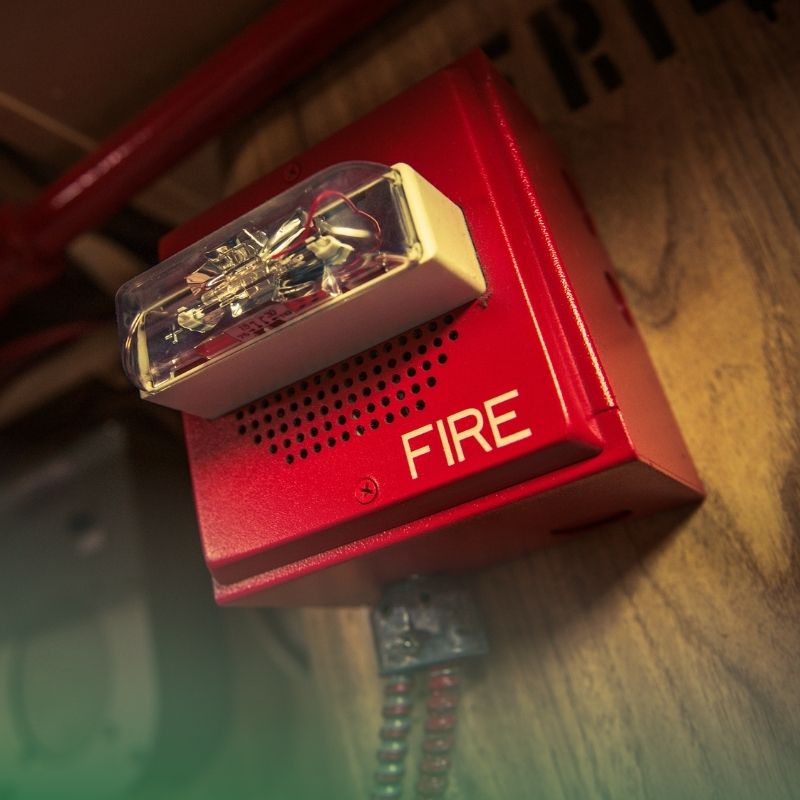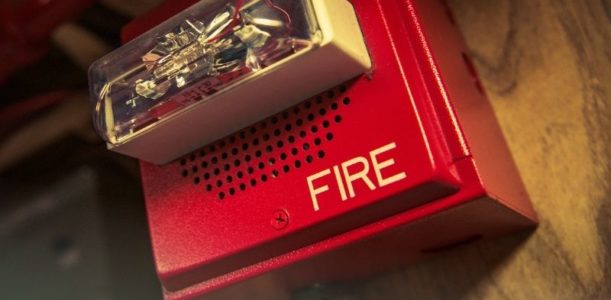
Commercial fire alarm systems and life safety technology continue to evolve at a rapid rate, replacing traditional alarms that simply notify occupants of a potential fire event. Fire alarm systems in the past could be unconnected and even manual alarms that never answered the questions of what exactly the emergency is, where the problem originated, or which is the best way to evacuate. Additionally, these outdated systems may not alert emergency personnel or the fire department at all.
Sophisticated fire alarm systems today are an element of an advanced network of wirelessly connected devices that do far more than sound an alarm. Intelligent fire safety system components can sense smoke and fire, recognize the presence of dangerous gasses, send status reports to a central monitoring location, direct evacuations audibly and visually, trigger fire suppression systems, contact the fire department, and provide real-time status information to arriving firefighters.
The fire alarm design can also combine with access control and security monitoring to recognize and respond to other potential physical threats to the building or campus.
Trends in Fire Safety
According to the United States Fire Administration, USFA, the country has experienced remarkable progress in reducing the impact of fires with several factors contributing to this progress. Some of the most important improvements in fire safety include:
- Smoke alarms – the USFA continues to partner with government agencies, fire safety service entities and fire alarm manufacturers to improve and develop new smoke alarm technologies. One example would be the first self-testing smoke detectors introduced by NOTIFIER™ by Honeywell, a leader in fire safety system technologies.
- Sprinklers – designed to quickly combat developing fires and are mandatory by code requirements and certain types of buildings and businesses. Trends in the U.S. include requiring the use of sprinklers in new homes which could improve the instance of residential sprinklers in the future.
- Fire safety codes – the National Fire Protection Association, NFPA, continues to evaluate and strengthen fire safety code requirements.
- Construction materials – materials and techniques have been developed to specifically mitigate risk of fire.
- Public education – education continues at all levels including local communities, counties, state, and federal levels to increase awareness of fire safety technologies and requirements.
Firefighter equipment and training – improvements in firefighter gear, equipment and training continue to evolve with the goal of saving lives, preventing injury and property damage while protecting emergency responders.
In spite of these improvements and a reduction of fires in the United States from the time period of this report from 2008 to 2017, there is still a lot of work to be done to continue reducing the number of fires and injuries. Specific areas for concern include addressing wildland, outside fires and the fact that the elderly remain at the highest risk of death from fire. Regarding the number of reported fires, outside fires continue to be the largest category with 43%, this includes fires in vacant lots in fields. There are more residential structure fires than nonresidential structure fires but almost 3 to 1, although nonresidential fires come close to the dollar value of losses sustained.
Retrofitting an Older Fire Alarm System
Building owners and facility managers of large building complexes and high-rise structures should be aware of the latest technologies for fire alarm design, detection, and notification. If your systems are outdated, the risks of life and property loss are far greater. As you consider a renovation of your older property or recognize that your fire alarm system is inadequate, upgrading the fire and security alarm systems should be the main priority.
The first step in fire alarm design is to consult your local fire authorities and work with a reputable licensed fire equipment company to develop a fire alarm design that integrates the most effective system into your building. Experts can survey your building and identify where deficiencies exist and offer solutions to upgrade the efficiency of your systems. In many cases, retrofitting your fire safety systems is necessary to raise the entire system to meet local code and OSHA requirements.
Why Retrofit Your Building Fire Detection and Alarm Systems?
The safety of your building’s occupants is the primary responsibility of an owner or facilities manager. As buildings age, the fire monitoring systems are also aging, becoming less reliable, inadequate, or outdated.
Why would retrofitting your building’s fire safety systems into a more modern fire alarm design be warranted? Here are some reasons to consider:
- Fire safety code requirements – local, state, or federal fire safety regulations may have changed.
- Fire safety inspection – a recent fire safety inspection may have revealed upgrades or retrofits required to maintain code compliance.
- Insurance requirements – upgrades may be required for continued coverage.
- Building usage – the usage of a building may have changed with a change to a business model, types of storage or a production line. This may require a retrofit of the fire and life safety system.
- Maximum protection – a building owner may upgrade or retrofit the fire and life safety system to continue to provide maximum protection for occupants in the building.
Retrofitting A New Fire Alarm Design
Whether a massive renovation or a modest retrofit of individual systems is required, the process begins with the fire alarm system design. Working with a licensed and reputable fire safety company with proven experience like High Rise Security Systems, HRSS, with SMG Security Holdings, SMG is mandatory for any fire alarm system retrofit. A licensed expert can evaluate the structure and make recommendations for the types of detection devices and alarm systems needed for your building. Since every structure has different uses and requirements, the types, placement, and number of devices will vary from one structure to the next.
HRSS/SMG offers a full fire safety system design team that can replicate your floor plan with computer-aided design (CAD) technology and in-depth expertise of all fire safety code regulations. We detail the exact location of all fire and smoke detection devices and determine the best evacuation route from every location in every building. Working with a professional fire alarm company like HRSS/SMG ensures that your fire alarm system will meet with full approval from all local fire authorities and meet all state and federal regulations.
Systems to Consider
Modern fire safety systems include interconnected devices that will detect, notify, direct, monitor, and communicate to all occupants. Fire and life safety systems must ensure universal awareness by occupants, management, the local fire department, and emergency response teams of a potential emergency as soon as it occurs. Rapid response is essential to saving lives and property.
Devices may be interconnected to perform all of these functions instantly. While there is a range of individual devices and systems available on the market today, NOTIFIER™️ by Honeywell systems provides a comprehensive and holistic approach to fire safety and security with an integrated, fully networkable system.
Fire Alarm Control Panels
A state-of-the-art fire system starts with the control panels. NOTIFIER offers their Onyx Series which can network with small systems or large high-rise or multi-building configurations. The system is modular, so adding new devices can be a simple process. A complete spectrum of detection and warning peripherals are available to complement the system.
Smoke and Fire Detection
Most fire emergencies are first detected by smoke sensors that imply the presence of a fire. There are two main types of smoke detection devices, each using different criteria for detection.
The most widely used category of smoke detector uses photoelectric recognition. These devices incorporate a stream of light and a mirror. Any smoke that enters the chamber will refract the stream of light away from the mirror and initiate the alarm.
The second type of smoke alarm employs ionization technology. The system produces a continuous stream of electricity between two metal plates. When smoke particles enter the device and disrupt the current, the alarm will sound. This system works best for detecting quickly developing fires, as opposed to smoldering and slow developing fires.
The Occupational Safety and Health Administration, OSHA, recommends a smoke detection system that integrates both technologies in your fire alarm design. The latest innovation from NOTIFIER includes the first UL listed self-testing smoke detectors, saving considerable time and money without the need to reach high ceilings or hard to access places for regular testing and inspections. The NOTIFIER Advanced Multi-Criteria smoke detection systems employ four different techniques for greater protection. Besides ionization and photoelectric smoke detection, the device incorporates thermal and carbon monoxide sensing.
Gas Detection
Wherever particularly noxious or dangerous gasses may be present, such as in a chemical plant or laboratory, installing top-of-the-line detection devices is essential. These may be fixed in place or portable, depending on the locations and potential for escaping gas.
Notification Systems
Once an emergency is detected, instant notification is essential to reduce the threat to occupants and property. The detection devices can wirelessly transmit instant alerts through audible alarms, bells, and horns as well as prerecorded verbal evacuation instructions. Visual messages are also available with strobe lights and LED message boards directing occupants to evacuate to safe areas.
Simultaneously, the detection devices can wirelessly alert the central control location of the building, the local fire department, and the fire monitoring service.
Fire Suppression
During a building retrofit, the installation of sprinklers or fire suppression devices may be a priority. In some instances, this addition could be a requirement, depending on the types of materials that will be present or to protect historical elements within the structure.
Powering the System
During a retrofit design process, a decision about choosing a wired or wireless fire alarm system is necessary. Rewiring an existing building can be extensive. Completely wireless systems exist and can have the same communications capability as wired systems.
Though wired fire systems will always require a backup power source in situations when electric power disappears, a wireless system needs an effective battery management program to ensure proper performance.
Regular maintenance and inspection by a professional monitoring service are always a necessity. Checking and changing batteries while testing the entire system is always a requirement.
Peripheral Devices and Capabilities
NOTIFIER by Honeywell offers many peripheral devices to enhance a building’s retrofit. Consider integrating your fire monitoring systems with your access control protocol. Closed circuit television (CCTV) cameras, strategically placed, can provide security personnel with information about the status of any emergency while also detecting the presence of unauthorized personnel.
Central door locking and unlocking is a standard feature of modern buildings. Whether to lock certain areas of the building, instantly for security purposes or to unlock all egress points for safe evacuation, this feature is important to consider.
Bringing it All Together with Wireless Communications
By creating a wireless network within your building in the fire alarm design, every device can virtually communicate with each other. Notifications transmit to a central point-of-control workstation for immediate recognition and response. Information to and from fire alarm control panels, sensors, CCTV, and access control points, will display on central monitors for real-time scrutiny.
As emergency response teams arrive, correctly placed attenuators can provide immediate visual information regarding the status of the emergency.
How to Create Evacuation Plans and Procedures
OSHA offers this eTool to help small, retail, or low hazard businesses implement an emergency evacuation and action plan that complies with OSHA’s emergency standards.
High Rise Security Systems with SMG Security Holdings
In the Chicago area, High Rise Security Systems with SMG Security Holdings is a leader in protecting commercial buildings, campuses, hospitals, and all of their occupants from the threat of fire and danger of unwanted intrusions. Certified by NICET (National Institute of Certification for Engineering Technologies) and offering UL® listed equipment, HRSS/SMG designs, services, and monitors the most sophisticated fire safety equipment available.
Retrofitting an older building to provide security and peace of mind for all can be a very complicated proposition. Real experts in the field of fire safety like HRSS/SMG can provide economical and highly efficient solutions to retrofit your building into a modern, technologically safe structure and reduce worries about safety and security. Contact HRSS/SMG to learn more about retrofitting your fire alarm and life safety system.



